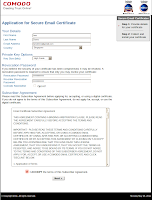- Apply for a free certificate from Comodo.
- The certificate will be automatically installed to your browser when you click on the link in the email from Comodo.
- Install the "Gmail S/MIME" addon from the Firefox addon source.
- Log into Gmail and the "Encrypt" icon is visible when you compose new mails.
Encrypted mails
I decided to install a digital certificate for my Gmail account. This is simple and free to set up.
Subscribe to:
Post Comments (Atom)
Ubuntu maintenance script
Wrote a simple script for keeping packages and snaps updated in Ubuntu.
-
This annoying message popped up after I ran the update in avast! in Ubuntu yesterday. avast! crashes every time I attempt to launch it after...
-
I decided to install a digital certificate for my Gmail account. This is simple and free to set up. Apply for a free certificate from Comod...






This is nice but I have a doubt:
ReplyDeleteThis would work with any e-mail address used in gmail (in firefox)..? And if we want the same for Opera or Chromium then what to do?
The Digital Certificate is not restricted to Gmail or Firefox. It can work with any browser or webmail as long as you can get a plugin that accepts the cert and can make use of it. I have tested the Digital Certificate in IE and Outlook. Just figure out how to import the cert into what software you want to use it with.
ReplyDeleteBut as you write to install "Gmail S/MIME" addon, does it work only for gmail?
ReplyDeleteYou can read more about "Gmail S/MIME" here.
ReplyDeletehttps://addons.mozilla.org/en-US/firefox/addon/gmail-smime/developers
If you are using an email client, import your Digital Certificate into that client to encrypt and decrypt mails. I use the above plugin because I do not use email clients.
thanks for posting! im going to do this also with my gmail account, its always very important to keep your account secured.
ReplyDelete@digital certificate... do note that using this plugin/cert has its own risks... because mails are encrypted... it can be used to hide malicious code also...
ReplyDelete